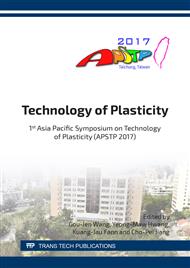p.40
p.46
p.52
p.58
p.64
p.70
p.77
p.83
p.89
Deep Drawability of Ti/Steel/Ti Laminated Sheets
Abstract:
Cladding is the bonding together of dissimilar metals. One of clad products is the titanium clad steel sheet. It is effective to cover with pure titanium sheet to improve the corrosion resistance of the steel sheet. Titanium clad steel sheets are often achieved by rolling sheets together under high pressure. In the current study, the blank comprising three laminar non-bonded sheets, such as the titanium/steel/titanium sheet, is arranged in the die. The formability of pure titanium clad sheet by multistage deep drawing was investigated to enhance corrosion resistance of steel cup. In the experiment, the blanks were pure titanium sheets JIS1-TP270, JIS2-TP340, ultralow-carbon steel SPCC, and stainless steel SUS316L. The initial thickness of the sheet was 0.2 to 0.5 mm in thickness. The blank diameter was 70 mm. The blanks are merely adjacent sheet; however, not joined with each other. In the deep drawing process, a hydraulic press was used in the experiment and the forming speed for the press was about 10 mm/min. The lubricant used was the solid powders of molybdenum disulfide. For the prevention, pure titanium blank was treated by oxide coating. The conditions of heat treatment were annealed at 973 K for 3.6 ks to 7.2 ks. By oxide coating, the titanium sheet has sufficient ability in preventing the seizure in multistage deep drawing. The drawn cups of the three-layer laminated sheet were formed. The seizure did not cause. The oxidatively-treated titanium sheets have sufficient ability in preventing the seizure. In addition, the clad cups until 6th stage were formed by multistage deep drawing. Long clad cups were successfully formed in multistage deep drawing process.
Info:
Periodical:
Pages:
64-69
Citation:
Online since:
April 2018
Authors:
Keywords:
Price:
Сopyright:
© 2018 Trans Tech Publications Ltd. All Rights Reserved
Share:
Citation:


